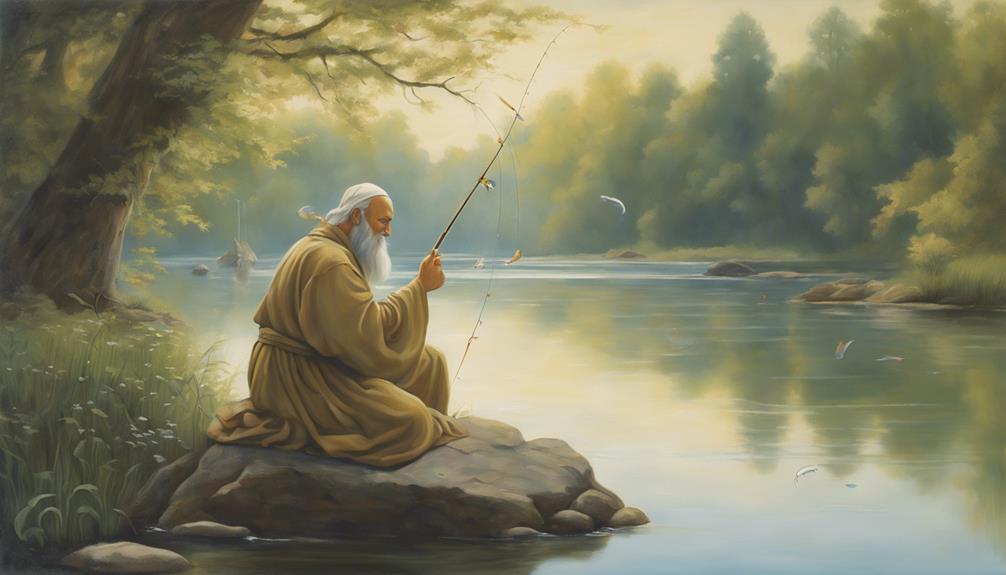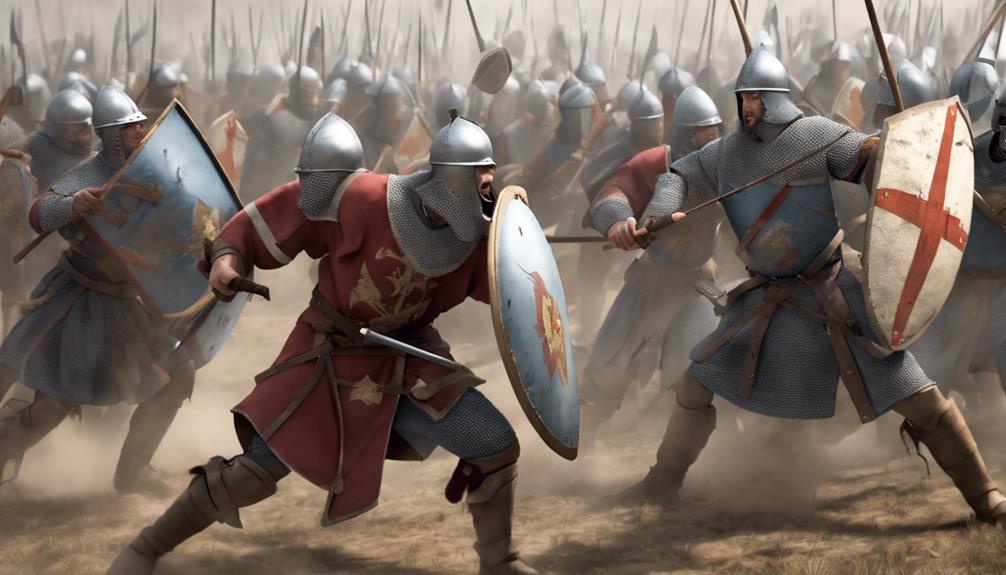Historic art often featured fishing and angling to convey deep meanings. Fishing symbolized patience, life's cycles, and abundance. Artists used fish to represent goals, transformation, and spiritual enlightenment. These themes reflected human connection with nature. The art showcased sustenance, community, and exploration. Fishing scenes varied, reflecting cultural values and artistic styles. From ancient cave paintings to detailed Renaissance art, fishing evolved in significance. Angling provided insights into historical practices and societal values. Artists depicted fishing saints and techniques like handlining. The portrayal of fishing reflected ecological knowledge and spiritual symbolism. Fishing's influence on art movements reveals deeper truths and spiritual connections.
Early Depictions of Angling in Art
Early depictions of angling in art showcase the timeless connection between humans and the act of fishing, reflecting the cultural significance of this practice throughout history. Iconic portrayals and artistic interpretations of angling can be found in various forms of art, ranging from paintings to sculptures, providing insight into the early symbolism and cultural representations associated with fishing.
In ancient art, fishing scenes were often depicted on pottery, murals, and sculptures, highlighting the importance of fishing in sustaining communities and economies. These early artistic interpretations not only served as a documentation of daily life but also symbolized themes such as abundance, sustenance, and the harmony between humans and nature.
The act of fishing wasn't merely a means of survival but also held symbolic significance in many cultures. For instance, in Egyptian art, fishing was often associated with the Nile River and the cycle of life and death. Similarly, in Greek mythology, fishing was linked to gods and heroes, adding a layer of mystique and reverence to the practice.
Through these early depictions of angling in art, one can discern the intricate relationship between humans and fishing, transcending mere sustenance to embody cultural, spiritual, and social facets of society. The artistic representations of fishing serve as a window to the past, offering valuable insights into the significance and symbolism attached to this age-old practice.
Symbolism of Fishing in Paintings
Fishing in paintings has long served as a powerful symbol, weaving intricate narratives that transcend mere imagery to convey deeper meanings and cultural significance. The act of fishing is rich in symbolism, often representing themes such as patience, perseverance, and the cycle of life and death. In many paintings, the fishing rod itself can symbolize a tool for exploration and discovery, reflecting the human desire to seek out new experiences and knowledge.
Furthermore, the fish, being the ultimate prize of the fishing endeavor, holds its own symbolic weight. Fish are often associated with abundance, fertility, and transformation across various cultures and belief systems. The act of catching a fish can symbolize the attainment of goals, the fulfillment of desires, or even spiritual enlightenment. In religious contexts, fish have been symbolically linked to aspects of faith and salvation.
Moreover, fishing scenes in paintings can also carry social significance. They may depict themes of sustenance, community, and the interconnectedness of humankind with nature. The presence of fishing in art can serve as a reminder of our reliance on the environment and the delicate balance required for survival.
Fishing Scenes in Ancient Art
What artistic techniques were employed to depict fishing scenes in ancient art that set them apart from contemporary representations? Fishing scenes in ancient art often served as a window into the daily lives of coastal communities, capturing the essence of their relationship with marine life. Here are three key elements that distinguish ancient fishing scenes:
- Depiction of Marine Life: Ancient art frequently showcased intricate details of various marine species, highlighting the connection between fishermen and the sea. Artists meticulously painted schools of fish, majestic whales, and other creatures to emphasize the abundance of marine life surrounding these ancient communities. The vibrant colors and lifelike depictions offered viewers a glimpse into the diverse aquatic world that was fundamental to the livelihood of coastal societies.
- Symbolism of Fishing Equipment: Ancient artists skillfully portrayed the tools and techniques used in fishing, such as nets, harpoons, and boats. These objects weren't merely props but symbols of the ingenuity and resourcefulness of ancient fishermen. The intricate designs of fishing equipment in art underscored the importance of these tools in sustaining coastal communities and their reliance on fishing for survival.
- Integration of Ritual and Tradition: Fishing scenes in ancient art often incorporated rituals and traditions associated with the practice of fishing. From ceremonial dances before a fishing expedition to offerings made to sea deities for a bountiful catch, these artistic representations highlighted the spiritual connection between fishermen and the sea. The inclusion of such rituals added depth and cultural significance to depictions of fishing scenes in ancient art.
Evolution of Fishing Imagery
The development of fishing imagery throughout history reveals a fascinating evolution in artistic representation and cultural symbolism. From ancient cave paintings to Renaissance masterpieces, the artistic interpretations of fishing symbolism have shifted and transformed over time. In the earliest depictions, such as those found in prehistoric rock art, fishing scenes were simplistic yet crucial, showcasing the significance of fishing for sustenance and survival. As societies progressed, so did the complexity and depth of angling imagery in art.
During the medieval period, fishing imagery began to take on religious connotations, with fish symbolizing spiritual abundance and Christian virtues. Artists incorporated biblical narratives like the miraculous catch of fish by Jesus into their works, blending the practicality of fishing with symbolic meanings. This historical evolution of angling imagery continued into the Renaissance, where fishing scenes became more nuanced and detailed. Artists like Pieter Bruegel the Elder depicted lively fishing villages, capturing the daily life and labor of fishermen with a heightened sense of realism.
As art moved into the Baroque and Rococo periods, fishing imagery became intertwined with themes of leisure and pleasure. Paintings portrayed aristocrats engaging in recreational fishing, highlighting the sport's social status and refinement. The evolution of fishing imagery in art not only reflects changes in artistic styles and techniques but also mirrors the shifting cultural significance of angling throughout history.
Cultural Significance of Angling Art
The evolution of angling imagery in art highlights the dynamic interplay between cultural values and artistic expression, unveiling the nuanced layers of meaning embedded within depictions of fishing activities. Angling art reflects the rich tapestry of cultural traditions and societal values, offering a window into the past and providing insights into the artistic interpretations of fishing practices.
- Artistic Expressions: Angling art serves as a medium through which artists depict the beauty and tranquility of fishing scenes, capturing the essence of this ancient practice through various artistic styles and techniques. From serene watercolor paintings to intricate woodblock prints, each piece of angling art conveys a unique artistic expression that reflects the artist's perception of fishing activities.
- Cultural Traditions: The portrayal of fishing in art is deeply intertwined with cultural traditions, symbolizing themes such as patience, harmony with nature, and the cycle of life. These cultural elements are intricately woven into angling art, providing viewers with a glimpse into the historical significance of fishing within different societies and cultures.
- Societal Values: Through artistic interpretations, angling art often mirrors societal values and norms, showcasing the importance of fishing as a means of sustenance, leisure, or spiritual connection. By examining these depictions, one can discern the evolving attitudes towards fishing and angling practices across different time periods and regions.
Techniques Represented in Historical Art
In exploring historical angling art, various techniques emerge as pivotal in capturing the essence and intricacies of fishing practices throughout different periods. Techniques represented in historical fishing art provide a window into the methods and tools used by anglers in the past. Artists often depicted these techniques with great attention to detail, showcasing the skill and precision required in fishing during different historical contexts.
One common technique depicted in historical fishing art is handlining, where a single fishing line is held in the hand or attached to a pole. Artists often illustrated the process of handlining with intricate details, showcasing the delicate balance required to reel in a catch successfully. This technique was prevalent in many cultures and time periods, providing a snapshot of the widespread practice of handlining in fishing history.
Another technique frequently portrayed in historical angling art is net fishing. Artists captured the complexity of net fishing, illustrating the teamwork and coordination needed to operate large fishing nets. These artworks not only showcase the technical aspects of net fishing but also provide insight into the social dynamics and collaborative efforts involved in this fishing method.
Moreover, historical fishing art often depicted the use of various bait and lure techniques. Artists skillfully illustrated the different baits and lures used in fishing, highlighting the importance of selecting the right bait to attract specific fish species. These details not only showcase the diversity of fishing techniques but also provide valuable information about the ecological knowledge of anglers in different historical periods.
Religious References in Fishing Art

Diving into historical angling art reveals a rich tapestry of religious references intertwined with the depiction of fishing practices. Artists often incorporated biblical connections and spiritual symbolism into their works, adding layers of meaning to what may seem like simple portrayals of fishing activities.
Here are three ways in which religious references were commonly depicted in fishing art:
- The Miraculous Catch of Fish: One prevalent theme in religious fishing art is the depiction of the biblical story where Jesus instructs his disciples to cast their nets to the other side of the boat, resulting in a miraculous catch of fish. This event symbolizes faith, obedience, and divine intervention, often portrayed with a sense of awe and wonder in artistic representations.
- Fish Symbolism: Fish hold significant symbolism in various religious contexts. In Christian art, fish are often associated with Jesus Christ and his disciples who were referred to as 'fishers of men.' Artists would incorporate fish motifs in their works to allude to spiritual teachings, emphasizing themes of transformation, abundance, and salvation.
- Depiction of Fishing Saints: Many religious traditions venerate saints who were fishermen or had significant encounters with fish. Artworks portraying these fishing saints not only showcase their earthly occupation but also highlight their spiritual virtues and the divine grace present in their lives, inspiring viewers to reflect on the intersection of faith and everyday activities.
Influence of Angling on Artistic Movements
Exploring the realm of historical angling art unveils a profound connection between fishing practices and their impact on various artistic movements. During the Renaissance period, angling inspiration played a significant role in shaping artistic styles. Artists like Leonardo da Vinci and Albrecht Dürer depicted fishing scenes in their works, showcasing the serene beauty and meditative quality of angling. The act of fishing was often used as a metaphor for human contemplation and spiritual reflection, influencing the peaceful compositions and naturalistic elements seen in Renaissance art.
Moving into the Baroque era, fishing symbolism took on new meanings in artistic interpretations. Baroque artists such as Caravaggio and Diego Velázquez used fishing motifs to symbolize themes of patience, perseverance, and the passage of time. The dynamic and dramatic nature of Baroque art was often juxtaposed with the calmness and tranquility associated with fishing, creating a visual tension that captivated viewers. The intricate details of fishing equipment, the play of light on water, and the symbolism of fish as metaphors for deeper truths all contributed to the rich tapestry of Baroque art.
Frequently Asked Questions
How Did the Portrayal of Fishing Change Over Different Historical Periods?
When examining the portrayal of fishing over various historical periods, you'll notice a significant evolution in fishing techniques and cultural significance. Through different eras, the depiction of fishing transformed from a basic survival skill to a revered art form and leisure activity.
Artists captured the essence of these changes by showcasing advancements in equipment, techniques, and the evolving societal views towards fishing. This evolution mirrors the broader shifts in human civilization and values throughout history.
Were There Any Famous Artists Known for Their Fishing-Themed Artworks?
When it comes to famous artists known for their fishing-themed artworks, several prominent names stand out in art history.
These artists skillfully depicted various fishing techniques in their works, capturing the essence of angling with precision and artistry.
Through their paintings, sculptures, and drawings, these masters showcased the beauty and significance of fishing in a way that continues to resonate with audiences today.
Did Ancient Civilizations Use Fishing Scenes to Convey Political Messages?
Ancient civilizations utilized fishing scenes in artworks not just for sustenance but also to convey political messages.
The depiction of fishing activities was often laden with political symbolism, serving as a subtle yet powerful tool for expressing societal hierarchies, economic policies, and power dynamics.
Through artistic expression, these civilizations ingeniously embedded political narratives within seemingly ordinary fishing scenes, showcasing the interconnectedness of art and politics in historical contexts.
What Materials Were Commonly Used to Create Fishing Art in the Past?
When creating fishing art in the past, artists commonly utilized various materials like clay, stone, and metal. These ancient techniques allowed for intricate detailing and durability. Symbolic meanings were often conveyed through the choice of materials, with each substance carrying its unique significance.
Understanding the materials used in historic fishing art provides insights into the craftsmanship and cultural symbolism embedded in these artworks.
How Has the Depiction of Fishing in Art Influenced Modern-Day Fishing Culture?
When it comes to how the depiction of fishing in art has influenced modern-day fishing culture, it's fascinating to see the impact of symbolism and representation.
Through historic artworks showcasing fishing, a deep connection to nature, patience, and the thrill of the catch has been ingrained in the cultural fabric of anglers today.
These visual representations haven't only inspired techniques and gear but have also shaped the values and rituals within modern fishing communities.
Conclusion
Historic art often featured fishing and angling because it served as a symbol of patience, perseverance, and the interconnectedness of humans with nature.
The depiction of fishing scenes in art throughout history not only showcased the technical skill of the artist but also reflected cultural values, religious beliefs, and societal norms.
As fishing imagery evolved over time, it influenced artistic movements and continued to hold a significant place in the artistic representation of human experiences.



